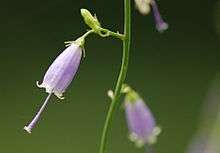Adenophora triphylla
Adenophora triphylla, also known as Japanese lady bell, is one of the 62 species of Adenophora.[3] It is a flowering plant in the family Campanulaceae that is distributed mainly over the Korean Peninsula, Japan, and China.[4]
| Adenophora triphylla | |
|---|---|
 | |
| Scientific classification | |
| Kingdom: | Plantae |
| Clade: | Tracheophytes |
| Clade: | Angiosperms |
| Clade: | Eudicots |
| Clade: | Asterids |
| Order: | Asterales |
| Family: | Campanulaceae |
| Genus: | Adenophora |
| Species: | A. triphylla |
| Binomial name | |
| Adenophora triphylla | |
| Synonyms[1] | |
| |
Ecology


Adenophora triphylla is an erect, perennial herb growing to 100 centimetres (39 in) in height.[4] It has a white and thickened taproot, shaped like a carrot, 7-16 × 1.5-1.8 cm in diameter.[3] Stems are white pilose with alternately arranged leaves. It has oval, almost round, serrated leaves growing to 10 centimetres (3.9 in) that are white, sharply pointed, and pilose. A. triphylla flowers are about 13 millimetres (0.51 in)-22 millimetres (0.87 in) long and have both male and female organs (hermaphrodite), each having 5 stamens and a pistil (the long head of the pistil overhangs the flower). Flowers are pollinated by insects. Seeds are yellow-brown colored and oblong slightly compressed, 1 millimetre (0.039 in)-1.5 millimetres (0.059 in).[3]
Cultivation details
Adenophora triphylla grows well in a warm and sunny or slightly shaded niche, but cannot grow in full shade; A. triphylla needs alkaline soil that is slightly moisturized, or peaty soil. Plants are hardy to about −20 °C (−4 °F). Slugs have been known to destroy its young growth or even mature plants.
Propagation
Adenophora triphylla grows wild in mountains and meadows, but is also cultivated. The seed can be sown in spring and germinates in 1–3 months. At that time, it needs a temperature of about 10 °C (50 °F). It can be planted out into a permanent positions while young.
Chemical constituents
Adenophora triphylla roots contain chemical compounds that are saponins and triterpenes.
Traditional medicine
In Korea, A. triphylla is traditionally used for sputum, cough and bronchial catarrh. It is believed to have antifungal, expectorant, and cardiotonic effects.[4]
References
- "Adenophora triphylla". Germplasm Resources Information Network (GRIN). Agricultural Research Service (ARS), United States Department of Agriculture (USDA). Retrieved 28 November 2013.
- The basionym of this plant (Campanula triphylla) was originally described and published in Flora Japonica sistens plantas insularum japonicarum... 87. 1784. "Name - Campanula triphylla Thunb". Tropicos. Saint Louis, Missouri: Missouri Botanical Garden. Retrieved 28 October 2013.
- Flora of China. "Adenophora tetraphylla". Archived from the original on 2013-10-21.
- Natural Products Research Institute, Seoul National University. Medicinal Plants in the Republic of Korea. World Health Organization. p. 11. ISBN 92 9061 120 0.